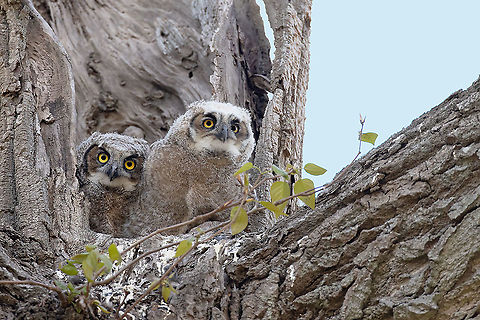
Appearance
Great Horned Owls are the heaviest extant owl in Central and South America and are the second heaviest owl in North America, after the closely related but very different looking Snowy Owl. They range in length from 43–64 cm and have a wingspan of 91–153 cm. Females are invariably somewhat larger than males. An average adult is around 55 cm long with a 124 cm wingspan and weighing about 1.4 kg. Depending on subspecies, Great Horned Owls can weigh from 0.6 to 2.6 kg. Among standard measurements, the tail measures 17.5–25 cm long, the wing chord measures 31.3–40 cm, the tarsal length is 5.4–8 cm and the bill is 3.3–5.2 cm.There is considerable variation in plumage coloration but not in body shape. These are heavily built, barrel-shaped birds, and have large heads and broad wings. Adults have large ear tufts and are the only very large owl in their range to have them. The facial disc is reddish, brown or gray in color and there is a variable sized white patch on the throat. The iris is yellow, except the amber-eyed South American Great Horned Owl. Its "horns" are neither ears nor horns, simply tufts of feathers. The underparts are usually light with some brown barring; the upper parts are generally mottled brown. Most subspecies are barred along the sides as well. The legs and feet are covered in feathers up to the talons, with some black skin peaking out from around the talons. The feet and talons are distinctly large and powerful and only other "Bubo" owls have comparable formidable feet. There are individual and regional variations in color; birds from the sub-Arctic are a washed-out, light-buff color, while those from Central America can be a dark chocolate brown.
Their call is a low-pitched but loud "ho-ho-hoo hoo hoo"; sometimes it is only four syllables instead of five. The female's call is higher and rises in pitch at the end of the call. Young owls still in the care of their parents make loud, persistent hissing or screeching sounds that are often confused with the calls of Barn Owls.
The combination of the species bulk, prominent ear-tufts and barred plumage distinguishes it through much of the range. However, Great Horned Owls can be easily confused with the Magellanic Horned Owl, with which they may have limited overlap in southermost South America. The Magellanic was once considered a subspecies of the Great Horned, but is markedly smaller with smaller feet and a smaller head and is generally more lightly barred on the underside. Other eagle-owls may superficially be somewhat similar, but the species is allopatric with the exception of the Magellanic species. In North America, the Long-eared Owl can be somewhat similarly marked and shares the feature of prominent ear tufts, but it is considerably smaller and more slender, with a grayish line running down the middle of the facial disc and with ear tufts located more closely to each other on the top of the head.
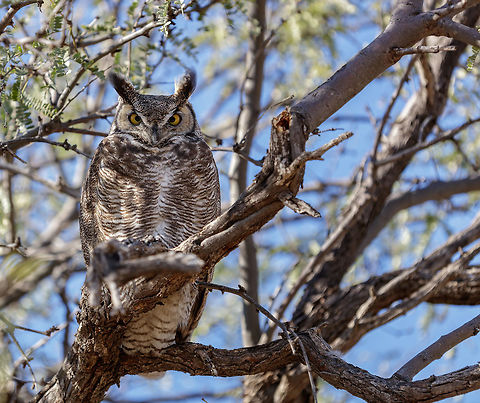
Naming
A large number of subspecies have been named. As indicated above, many of these are only examples of individual or clinal variation. Subspecies differences are mainly in color and size and generally follow Gloger's and Bergmann's Rules:⤷ Common Great Horned Owl, "Bubo virginianus virginianus"
⟶ USA eastwards from Minnesota to Texas; northeastwards to Nova Scotia and Prince Edward Island, Canada. Resident all-year.
⟶ A brown form, tinged rufous and barred distinctly blackish-brown below. Feet tawny to buff, often barred black.
⤷ South American Great Horned Owl, "Bubo virginianus nacurutu"
⟶ A lowland form occurring in disjunct populations from E Colombia to the Guyanas; also from Bolivia and Brazil south of the Amazonas basin to N Argentina; resident all-year. Includes the proposed subspecies "scotinus", "elutus", and "deserti". The status of this form, especially the relationships between the subpopulations and with ssp. "nigrescens" and the Magellanic Horned Owl, deserves more study.
⟶ Dull brownish with long bill; birds from the semiarid interior of Brazil often have much white on uppertail- and ear-coverts. It is the only subspecies where the iris is amber, not yellow.
⤷ Northern/Subarctic Great Horned Owl, "Bubo virginianus subarcticus" Hoy, 1852
⟶ Breeding range from Mackenzie, British Columbia region E to Hudson Bay; southern limit unclear but at least reaches to Montana and North Dakota. Non-breeding birds are regularly found south to latitude 45°S, occasionally beyond. Includes the birds described as "occidentalis" and "sclariventris". The older name "wapacuthu" was occasionally used for this subspecies, but it cannot with certainty be assigned to a recognizable taxon and is thus considered a "nomen dubium". The population described as "algistus" is probably based on wandering individuals and/or intergrades of "subarcticus", "saturatus" and "lagophonus".
⟶ A pale form, ground color essentially whitish with faint buff tinge above; black underside barring variable from indistinct to pronounced. Very pale birds are similar to a young female Snowy Owl from a distance. Feet whitish to buff, with little or no pattern. The largest-bodied subspecies.
⤷ Californian Great Horned Owl, "Bubo virginianus pacificus" Cassin, 1854
⟶ Central and southern California west of the Sierra Nevada except San Joaquin Valley, south to NW Baja California, Mexico. Intergrades with "pallescens" in San Diego County, California. Resident all-year.
⟶ Very rich brown, dark underside barring distinct but less pronounced than in "saturatus". Humeral area black. Feet mottled dark.
⤷ Coastal Great Horned Owl, "Bubo virginianus saturatus" Ridgway, 1877
⟶ Pacific coast from SE Alaska to N California. Resident all-year.
⟶ A dark, dull and somewhat greyish form with heavily barred underside. Feet fairly dusky overall.
⤷ North Andean Great Horned Owl, "Bubo virginianus nigrescens" Berlepsch, 1884
⟶ Andes; arid temperate and puna zones from Colombia to NW Peru. Resident all-year round.
⟶ A dark, cold gray-brown form with heavy fuscous blotching.
⤷ Desert Great Horned Owl, "Bubo virginianus pallescens" Stone, 1897
⟶ San Joaquin Valley southeastwards through arid regions of SE California and S Utah eastwards to W Kansas and southwards to Guerrero and W Veracruz in Mexico; intergrades with "pacificus" in San Diego County; vagrant individuals of "lagophonus" and the Rocky Mountains population, which look similar to intergrades, also seem to occur in its range. Resident all-year.
⟶ A small, pale dusky buff form with indistinct barring, especially on the underside. Humeral area umber. Feet white and usually unmarked.
⤷ Yucatán Great Horned Owl, "Bubo virginianus mayensis"
⟶ Yucatán Peninsula. Resident all-year.
⟶ A small and medium-pale form.
⤷ Baja California Great Horned Owl, "Bubo virginianus elachistus" Brewster, 1902
⟶ S Baja California, Mexico. Resident all-year.
⟶ Similar in color to "pacificus", but considerably smaller; some overlap though. In fact, it is the smallest subspecies overall.
⤷ Northeastern Great Horned Owl, "Bubo virginianus heterocnemis"
⟶ Breeds in E Canada. In winter, disperses southwards to Ontario to NE USA. Doubtfully distinct from "saturatus".
⟶ A fairly dark and grey, heavily barred form. Feet pale with dusky mottling.
⤷ Northwestern Great Horned Owl, "Bubo virginianus lagophonus"
⟶ Breeds from inland Alaska south through mountaineous areas of British Columbia to MA Oregon, the Snake River, and NW Montana. Reported in winter as far south as Colorado and Texas. Doubtfully distinct from "saturatus".
⟶ Greyer than "saturatus", but similar overall. Feet with dusky barring.
⤷ Central American Great Horned Owl, "Bubo virginianus mesembrinus"
⟶ Isthmus of Tehuantepec to W Panama. Resident all-year.
⟶ A mid-sized form; darker than "mayensis".
⤷ Rocky Mountains Great Horned Owl, "Bubo virginianus pinorum" Dickerman & Johnson, 2008
⟶ The Rocky Mountains population breeds south of the Snake River south to Arizona, New Mexico, and the Guadalupe Mountains. Westwards, it is presumed to occur to the Modoc Plateau and Mono Lake. They were included in the presumed subspecies "occidentalis", but recently described as distinct subspecies.
⟶ A medium gray form, intermediate between "lagophonus" and "pallescens". Moderately barred and tinged buff or ochraceous on the underside. Feet mottled.
The Pleistocene Sinclair Owl from California, "Bubo sinclairi", may have been be a paleosubspecies of the Great Horned Owl; if so, they were presumably the ancestors of the "pacificus/pallescens" group of subspecies.
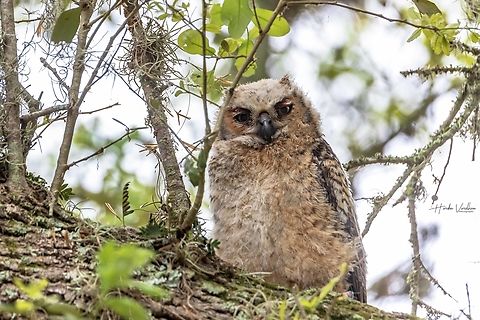
Distribution
The breeding habitat of the Great Horned Owl extends from subarctic North America throughout most of North and Central America and then down into South America south to Tierra del Fuego, the southern tip of the continent. They are absent from southern Guatemala, El Salvador and Nicaragua to Panama in Central, and Amazonia and the southwest in South America, as well as from the West Indies and indeed most off-shore islands. They are the most widely distributed owl in the Americas.They are amongst the world's most adaptable owls in terms of habitat. Great Horned Owls can take up residence in trees that include deciduous, coniferous, and mixed forests, tropical rainforests, pampas, prairie, mountainous areas, deserts, subarctic tundra, rocky coasts, mangrove swamp forests, and some urban areas. It is less common in the more extreme areas, generally absent from non-tidal wetland habitat, and missing from the high Arctic tundra. They prefer areas where open habitats, which they often hunt in, and woods, where they tend to roost and nest, are juxtaposed and thus lightly populated rural regions can be ideal. This species can occasionally be found in urban or suburban areas. However, they do seem to prefer areas with less human activity and are most likely to be found in park-like settings in such developed areas, unlike Eastern and Western Screech Owls which are regular in suburban settings. All mated Great Horned Owls are permanent residents of their territories, but unmated and younger birds move freely in search of company and a territory, and leave regions with little food in winter.
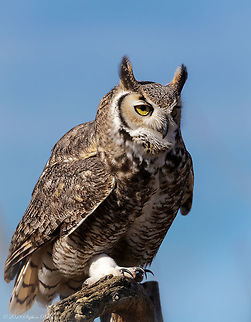
Behavior
Like most owls, Great Horned Owls make great use of secrecy and stealth. Due to their natural-colored plumage, they are well camouflaged both while active at night and while roosting during the day. Despite this, they can still sometimes be spotted on their daytime roosts, which are usually in large trees but may occasionally be on rocks. This regularly leads to them being mobbed by other birds, especially American crows. Since owls are, next to Red-tailed Hawks, perhaps the main predator of crows and their young, crows sometimes congregate from considerable distances to mob owls and caw angrily at them for hours on end. When the owls try to fly off to avoid this harassment, they are often followed by the corvids.Owls have spectacular binocular vision, allowing them to pinpoint prey and see in low light. The eyes of a Great Horned Owl are nearly as large as those of a human being and are immobile within their circular bone sockets. As a result, instead of turning its eyes, an owl must turn its whole head, the neck capable of rotating a full 270 degrees, in order to see in various directions without moving its entire body.
An owl's hearing is as good as, if not better than, its vision. Owls have better depth perception and better perception of sound elevation than human beings. This is due to owl ears not being located in the same position on both sides of the head. The right ear is typically set higher in the skull and at a slightly different angle. By tilting or turning its head until the sound is the same in both ears, an owl can pinpoint both the horizontal and vertical direction of the sound's source.
Owls also have approximately 300 pounds per square inch of crushing power in their talons, a PSI greater than the human hand is capable of exerting. In some cases the gripping power of the Great Horned Owl may be comparable to much larger raptor species such as the Golden Eagle.
Owls hunt mainly by watching from a snag, pole or other high perch, sometimes completely concealed by the dusky night and/or partially hidden by foliage. From such vantage points, owls dive down to the ground, often with wings folded, to ambush their prey. They also hunt by flying low over openings on the ground, scanning below for prey activity. On occasion owls may actually walk on the ground in pursuit of small prey or, rarely, inside a chicken coop to predate the fowl within. They have even been known to wade into shallow water for aquatic prey, although this has been only rarely reported. Owls can snatch birds and some arboreal mammals directly from tree branches as well. The stiff feathering of their wings allows owls to produce minimal sound in flight while hunting.
Almost all prey is killed with the owl's talons, often instantly, though some may be bitten about the face as well. Prey is swallowed whole when possible. However an owl will also fly with prey to a perch and tear off pieces with its bill. Very large prey, any that is notably heavier than the owl, must be eaten where it is killed for it is too heavy to fly with. In northern regions where such large prey is prevalent, an owl may let uneaten food freeze and then thaw it out later using its own body heat. When prey is swallowed whole, owls regurgitate pellets of bone and other non-digestible bits about 6 to 10 hours later, usually in the same location where the prey was consumed. Great Horned Owl pellets are dark gray or brown in color and very large, 7.6 to 10.2 cm long and 3.8 cm thick, and have been known to contain skulls up to 3 cm wide inside them.
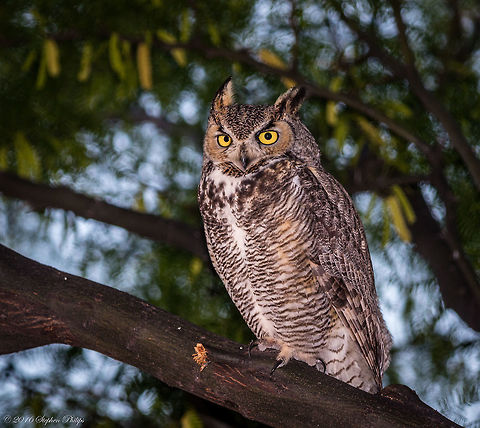
Habitat
The breeding habitat of the Great Horned Owl extends from subarctic North America throughout most of North and Central America and then down into South America south to Tierra del Fuego, the southern tip of the continent. They are absent from southern Guatemala, El Salvador and Nicaragua to Panama in Central, and Amazonia and the southwest in South America, as well as from the West Indies and indeed most off-shore islands. They are the most widely distributed owl in the Americas.They are amongst the world's most adaptable owls in terms of habitat. Great Horned Owls can take up residence in trees that include deciduous, coniferous, and mixed forests, tropical rainforests, pampas, prairie, mountainous areas, deserts, subarctic tundra, rocky coasts, mangrove swamp forests, and some urban areas. It is less common in the more extreme areas, generally absent from non-tidal wetland habitat, and missing from the high Arctic tundra. They prefer areas where open habitats, which they often hunt in, and woods, where they tend to roost and nest, are juxtaposed and thus lightly populated rural regions can be ideal. This species can occasionally be found in urban or suburban areas. However, they do seem to prefer areas with less human activity and are most likely to be found in park-like settings in such developed areas, unlike Eastern and Western Screech Owls which are regular in suburban settings. All mated Great Horned Owls are permanent residents of their territories, but unmated and younger birds move freely in search of company and a territory, and leave regions with little food in winter.
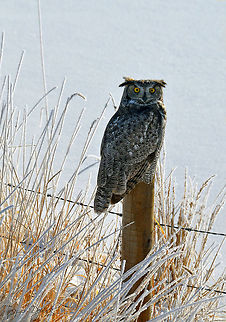
Reproduction
Great Horned Owls are some of the earliest-breeding birds in North America, seemingly in part because of the lengthy nightfall at this time of year. They breed in late January or early February and are often heard calling to each other regularly as early in the fall as October. They choose a mate by December and are often heard duetting before this time. For owls found in more tropical climates, the dates of the breeding season are somewhat undefined.The male attracts the attention of his mate by hooting emphatically while leaning over and puffing up his white throat to look like a ball. The female hoots back when the pair meet but is more subdued in both her hoot and display. Pairs typically breed together year after year and may mate for life, although they associate with each other more loosely when their young become mostly independent. Like all owls, Great Horned Owls do not build their own nest. They often take over a nest used by some other large bird, sometimes adding feathers to line the nest but usually not much more. Old crow and raven, Red-tailed Hawk or large squirrel nests are often favored in North America. However, they are far from dependent on the old nests of others and may use cavities in trees and snags, deserted buildings, and artificial platforms. Other nest sites have included a large gap in a tree trunk, sheltered depressions on rocks and even a heron's nest in the midst of a heronry. Males select nesting sites and bring the females attention to them by flying to them and then stomping on them.
There are usually 2 eggs per clutch, with a clutch ranging in size from 1 to 6 eggs, depending on environmental conditions. The average egg width is 1.8 in, the average length is 2.2 in and the average weight is 1.8 oz. The incubation period ranges from 28 to 37 days, averaging 33 days. The female alone does all the incubation and rarely moves from the nest, while the male owl captures food to bring to her. Brooding is almost continuous until the offspring are about 2 weeks old, after which it decreases. The male feeds both the female and the young for around 2 weeks after hatching. Young owls move onto nearby branches at 6 weeks and start to fly about a week later. However, the young are usually not competent fliers until they are about 10 to 12 weeks old. The offspring have still been seen begging for food in late October and most do not separate from their parents until right before they start to reproduce for the next clutch. Birds may not breed for another year or two, and are often vagrants until they establish their own territories.
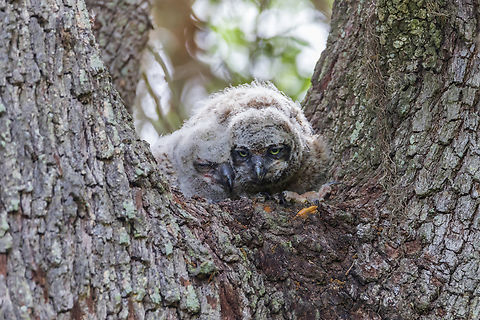
Food
Like most owls, Great Horned Owls make great use of secrecy and stealth. Due to their natural-colored plumage, they are well camouflaged both while active at night and while roosting during the day. Despite this, they can still sometimes be spotted on their daytime roosts, which are usually in large trees but may occasionally be on rocks. This regularly leads to them being mobbed by other birds, especially American crows. Since owls are, next to Red-tailed Hawks, perhaps the main predator of crows and their young, crows sometimes congregate from considerable distances to mob owls and caw angrily at them for hours on end. When the owls try to fly off to avoid this harassment, they are often followed by the corvids.Owls have spectacular binocular vision, allowing them to pinpoint prey and see in low light. The eyes of a Great Horned Owl are nearly as large as those of a human being and are immobile within their circular bone sockets. As a result, instead of turning its eyes, an owl must turn its whole head, the neck capable of rotating a full 270 degrees, in order to see in various directions without moving its entire body.
An owl's hearing is as good as, if not better than, its vision. Owls have better depth perception and better perception of sound elevation than human beings. This is due to owl ears not being located in the same position on both sides of the head. The right ear is typically set higher in the skull and at a slightly different angle. By tilting or turning its head until the sound is the same in both ears, an owl can pinpoint both the horizontal and vertical direction of the sound's source.
Owls also have approximately 300 pounds per square inch of crushing power in their talons, a PSI greater than the human hand is capable of exerting. In some cases the gripping power of the Great Horned Owl may be comparable to much larger raptor species such as the Golden Eagle.
Owls hunt mainly by watching from a snag, pole or other high perch, sometimes completely concealed by the dusky night and/or partially hidden by foliage. From such vantage points, owls dive down to the ground, often with wings folded, to ambush their prey. They also hunt by flying low over openings on the ground, scanning below for prey activity. On occasion owls may actually walk on the ground in pursuit of small prey or, rarely, inside a chicken coop to predate the fowl within. They have even been known to wade into shallow water for aquatic prey, although this has been only rarely reported. Owls can snatch birds and some arboreal mammals directly from tree branches as well. The stiff feathering of their wings allows owls to produce minimal sound in flight while hunting.
Almost all prey is killed with the owl's talons, often instantly, though some may be bitten about the face as well. Prey is swallowed whole when possible. However an owl will also fly with prey to a perch and tear off pieces with its bill. Very large prey, any that is notably heavier than the owl, must be eaten where it is killed for it is too heavy to fly with. In northern regions where such large prey is prevalent, an owl may let uneaten food freeze and then thaw it out later using its own body heat. When prey is swallowed whole, owls regurgitate pellets of bone and other non-digestible bits about 6 to 10 hours later, usually in the same location where the prey was consumed. Great Horned Owl pellets are dark gray or brown in color and very large, 7.6 to 10.2 cm long and 3.8 cm thick, and have been known to contain skulls up to 3 cm wide inside them.

Predators
Great Horned Owl eggs, nestlings and fledgings may be preyed on by foxes, coyotes, or wild or feral cats. There are almost no predators of adults, but they may be killed in confrontations with large eagles, Northern Goshawks, Snowy Owls and, mostly, other Great Horned Owls. Peregrine Falcons may harass them while defending their own young and themselves, but have not been known to kill adults. A rarely observed case of predation on an adult Great Horned Owl was photographed in Wisconsin when a Bald Eagle caught and killed one adjacent to a golf course. Wild owls have a maximum recorded lifespan of 13 years, whereas owls kept in captivity may live for up to 38 years.Most mortality in modern times is human-related. Great Horned Owls will occasionally fly into man-made objects, including powerlines that eletrocute them and may be killed on impact by buildings or cars. Most states and provinces have historically considered the species a pest due to the perceived threat it posed to small domestic fowl and potentially small game. Thus, small bounties were offered in trade for owl bodies. However, this owl only rarely attacks domestic animals or animals preferred by human hunters and performs a key role in naturally controlling the populations of its prey. Hunting and trapping may continue on a small scale but is now illegal in most countries. Education has largely changed public opinions of the Great Horned Owl and conservation efforts have assured the populations of the great predator are stable. Occasionally, these owls may inadvertently predate threatened species. Following the devastation to its populations from DDT, the reintroduction of the Peregrine Falcon was locally hampered due to predation on nestlings and adults by the Great Horned Owl. Far-ranging as it is, the Great Horned Owl is not considered a globally threatened species by the IUCN.
References:
Some text fragments are auto parsed from Wikipedia.